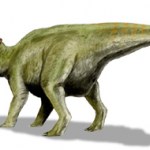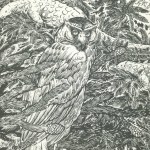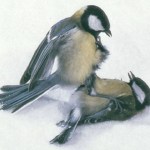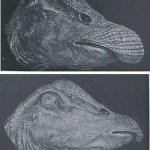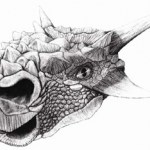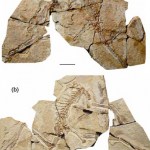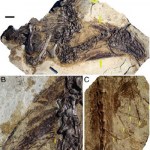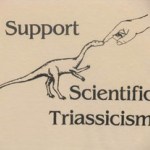Mesozoic dinosaurs
Once more, I'm going to start recycling some of those dinosaur texts written for the defunct field guide (for the back-story on that project see the ornithomimosaur article here). This time round, I'll get through some of the ceratopsians [adjacent skull reconstruction from wikipedia, and based on an image by Jaime Headden].
One of the most poorly known ceratopsians, Udanoceratops tschizhovi was a Mongolian species from the Santonian-Campanian Djadokhta Formation. Named in 1992 by Sergei Kurzanov, the holotype consists of an incomplete skull (the frill and everything around the orbital…
I've been seriously thinking about letting Tet Zoo lay fallow for a while, as I have a lot on right now and it's a horrendous distraction that I really shouldn't spend time on. Producing long articles like the one on the Sakhalin Island carcass are very satisfying, but they soak up a lot of time. The day job keeps me busy, well, all day, and academic and editorial commitments keep me busy most nights - and this is on top of having a new baby in the house. Today I made a special effort to just go out on my own and waste time looking at stuff in shops, purely because I feel immense pressure to…
I used to receive random unsolicited emails from an individual who strongly promoted the idea that birds could not not not not be dinosaurs, that the entire dinosaur family tree was screwed up beyond belief, that 'dinosaurs' had evolved from random assorted diverse archosaurs, that cladistics was rubbish, and that all mainstream palaeontologists were idiots.
For some reason, the study of dinosaurs attracts people with strong 'fringe' beliefs: this must be a by-product of popularity, as you don't get this with temnospondyls, fossil ostriches, Eocene primates, corals or sea jellies (at least…
Before I start: TIANYULONG TIANYULONG TIANYULONG TIANYULONG TIANYULONG.
Ok, moving on...
It is the contention of some that the field of Mesozoic reptile research is plagued with bizarre, nonsensical hypotheses. You may or may not agree with me that skim-feeding giant pterosaurs, wind-surfing sail-crested pterosaurs, dedicated-to-scavenging Tyrannosaurus, and crampon-using dromaeosaurs are all, shall we say, unlikely. In some cases the science has been done to smack these ideas down, in other cases it has not. In my opinion, one of the most illogical hypotheses entertained within recent…
More musings on dinosaury things from January 2009. For the back-story you'll need to see part 1 and part 2, both of which are on theropods (and, specifically, on maniraptorans). This time we look at ornithischians...
One ornithischian in particular has been the subject of much discussion lately. Namely, the Upper Cretaceous Mongolian ankylosaurid
Minotaurasaurus ramachandrani Miles & Miles, 2009. This isn't such an inappropriate name - after all, the holotype specimen does have bull-like horns that project outwards from above its eyes - but it doesn't sound very euphonious... and…
More dinosaury stuff from January 2009: for the background story, please see part I.
Last time we looked at therizinosauroids. Alvarezsaurids have also been the subject of much discussion lately. This is thanks to Ceratonykus oculatus, a new taxon from the Upper Cretaceous of Mongolia (Alifanov & Barsbold 2009). Alvarezsaurids have had a slightly confusing taxonomic history. For many people, it started in 1993 with Mononykus (then called Mononychus, a name preoccupied by a beetle), first described as a bizarre flightless bird closer to modern birds than to Archaeopteryx [reconstructed…
First of all, many many thanks to everyone (both here and at SV-POW!) for the congrats regarding baby Emma. I am, shall we say, a little tired right now, but as you'll know if you've visited SV-POW! this morning, the good news as goes blogging is that I've been able to get lots of stuff prepared in advance. In theory, therefore, things won't be so different here on Tet Zoo. The one thing I haven't had time to prepare is 'the reveal' on that mystery picture from the other day, but I'll get round to that soon, thanks for your patience. Ok, to business...
I think I've said before that I tend…
Oh my god. Two years at ScienceBlogs have passed, and Tet Zoo has now been going for three years. It all started on January 21st 2006 when, for no good reason at all, I started a blog over at blogspot.com. Yes, Tet Zoo is three years old. Time to look back at the past year of operation.
For starters, should you want to know more about Tet Zoo's origin and history of operation, read Happy first birthday Tetrapod Zoology part I and part II (both at ver 1), and Happy second birthday part I and part II. Last year, I included a 'what happened in tetrapods during 2007'. I'm not going to do the…
No time at the moment to complete anything for the blog, dammit. So only time for a picture of the day. Inspired by recent comments made here about the whereabouts of the Krayt dragon skeleton from Star Wars Episode IV: A New Hope, Matt Wedel has done a great job of both identifying the skeleton, and of tracking down its whereabouts. As he explains, palaeontologists have actually located the skeleton before (David Reynolds and Michael Ryan did so in 1995), and it was also 're-discovered' by the Lucasfilm people during the making of Episode II: The Clone Wars. Check out Matt's article on SV-…
Welcome to my final set of musing and recollections about our recent Moroccan trip, led by Nizar Ibrahim. Mostly I'll be talking here about the amazing desert birds we got to see, but I also have stuff to say about the mammals, and - of course - about the fossils...
One of the birds I most wanted to see - in fact it was top of my list - was the remarkable Greater hoopoe lark Alaemon alaudipes [see photo at top here for Richard's photo of one of these birds], and eventually we were to see four or five of these (though never more than one at the same time). Alaemon occurs across Africa and is…
More musings from the Morocco trip. So, we travelled over the Atlas Mountains and were soon up at the snowline. We joked about seeing lions and bears, but did see a Barbary partridge Alectoris barbara (another first) and a representative of the strikingly blue Blue tit subspecies Cyanistes caeruleus ultramarinus. If you've been keeping up with parid taxonomy you'll know that some workers now regard this blue tit of north-west Africa and the Canaries as a distinct species, the Ultramarine or Afrocanarian tit C. ultramarinus (but note that not all the blue tits of the Canaries belong to this…
I've been so busy over the past several weeks that I've totally failed to keep up with several of my favourite blogs. One of them is Andrea Cau's Theropoda, written in Italian but translatable into English thanks to the wonder of google's translator widget (incidentally, my grandmother on my dad's side was Italian). The amount of detail Andrea puts in to his posts is awesome, as are the many novel excellent illustrations he uses (virtually all of which he produces himself). And I've only just seen this, dating from early October...
Andrea posted it here, basically as a guessing game (all…
Another book review. I've had a lot of them to do lately.
The idea that feathers decorated and insulated the bodies of the small bird-like predatory dinosaurs of the Jurassic and Cretaceous - the coelurosaurs - is no longer a speculation limited to controversial artwork, but the mainstream view [for background info see Feathers and filaments part I and part II]. Spectacular fossils from the Lower Cretaceous rocks of Liaoning Province in north-east China have shown that feathers, and simpler, filament-like 'proto-feathers', were widespread among coelurosaurs, being present in compsognathids…
Yay - another one from the archives. This article first appeared on Tet Zoo ver 1 in April 2006 (here). If you've read it before, please have the decency to pretend that you haven't, thanks [excellent macronarian sauropods below from wikipedia].
I've stated before on this blog that I do quite a bit of consultancy work for companies that produce prehistoric animal books for children. In advising and assisting artists as often as I do, I find that they consistently screw up on the same things, every time. One of the biggest problem areas seems to be the hands and feet of sauropod dinosaurs - I…
Today sees the formal publication of the bizarre little Chinese maniraptoran theropod Epidexipteryx hui Zhang et al., 2008 from the Daohugou Formation of Ningcheng County, north-eastern China. Unfortunately the publication of this new species is not quite the surprise it should be, as the authors inadvertently submitted their manuscript to the wrong venue a few weeks ago, thereby making the article visible to the whole world some time before it was ready to be published. Anyway, we'll just have to pretend that never happened. Belonging to a recently discovered group called the…
I was going to title this post 'How a tyrannosaur was mounted', or 'How to mount a tyrannosaur', but that seemed childish. Eventually I went for a title based on a movie, as that isn't at all childish. If I could travel in time, high on the list of things to do would be visits to see dead animals: I don't just mean tyrannosaurs and azhdarchids, but also such things as thylacines and Passenger pigeons (think kilometre-wide super-flocks that took days to pass overhead, drowned out all other sound with their din, and blotted out the sun). But also high up on the list of priorities would be…
If you've been keeping an eye on the newswires you'll have seen that a very exciting new theropod dinosaur was described about a week ago now: Aerosteon riocoloradensis Sereno et al., 2008, an allosaurid allosauroid from the Santonian Anacleto Formation of Mendoza Province, Argentina. Hooray again for open-access publishing: Sereno et al. (2008) is published in PLoS ONE, and as such is 100%, no-holds-barred, open-access for the whole world (Fig. 16 from Sereno et al. (2008) shown here]. There is no question that Aerosteon is a neat animal and a very significant discovery. We have here a non-…
I've just been doing - if you will - Parasaurolophus for the day job. As in, writing about the history of its discovery and interpretation. William Parks first described Parasaurolophus walkeri (the first of several species to be named) in 1922, and noted in his paper that the skeleton was odd in possessing a weird roughened pad on the neural spine of one of the dorsal vertebrae. He proposed that this structure might have been connected to the tip of the bizarre tube-like crest: it was already thought by this time (thanks to Barnum Brown's Corythosaurus of 1914 and other specimens) that the…
For my shame, I had never been to Ireland prior to last week. That's so crap that I became pretty determined to attend the 56th SVPCA, hosted by the National Museum of Ireland at Dublin, and I'm glad I did. You know, because of the giant deer, hornbills and pliosaurs [montage here shows specimens from the (currently closed) National Museum of Ireland (Natural History). The middle skeleton is a Notoryctes]...
Here I'm going to do a very speedy review of most (but far from all) of the presentations given at the meeting. There was a reasonable amount of non-tetrapod stuff that I won't, of…
What with the recent articles here on tree-climbing dinosaurs and dromaeosaur tails it seems appropriate to post this image, taken in a German museum (but unfortunately I can't remember which one: let me know if you do). I don't know anything about the mount, but I guess that the people behind it wanted to present the idea that dromaeosaurs might have been in the habit of climbing on their prey during acts of predation, an idea since discussed more seriously by Manning et al. (2006) (although they proposed that the sickle-claws actually functioned as climbing crampons)...
Incidentally - I'm…
